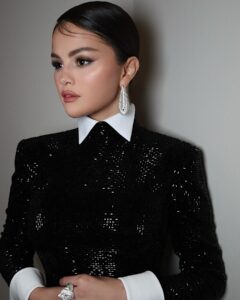
In a surprising turn of events, Billboard has publicly apologized to Taylor Swift after mistakenly including footage of her nude wax figure from Kanye West’s controversial music video.
The outlet expressed regret via Instagram, stating, “We are deeply sorry to Taylor Swift and all of our readers and viewers that in a video celebrating Swift’s achievements, we included a clip that falsely depicted her.”
This statement came after Billboard featured the clip in a montage celebrating Swift as the second greatest pop star of the 21st century.
The Context of the Feud
Background of the Swift and West Controversy
The clip in question is from Kanye West’s 2016 song “Famous,” which has been labeled as “revenge porn” by some of Swift’s fans.
This label stems from the long-standing feud between Swift and West, which began in 2009 when West interrupted Swift’s acceptance speech at the MTV Video Music Awards.
Swift’s Response to “Famous”
When “Famous” was released, Swift took to social media to deny any involvement in the song’s explicit content.
She stated, “Being falsely painted as a liar when I was never given the full story or played any part in the song is character assassination.”
This statement highlighted her desire to be excluded from the narrative that has surrounded her and West since their infamous encounter.
Reactions to the Billboard Incident
Swift’s Response
Although Swift did not directly comment on Billboard’s use of the nude wax figure, she showed her disapproval by liking various social media posts that criticized the clip.
This subtle action indicated her ongoing stance against being objectified and misrepresented in the media.
Support from Friends and Fans
Swift’s close friend, Lena Dunham, publicly condemned the video, calling it “sickening” and “disturbing.”
Dunham’s remarks reflect a broader sentiment among fans who feel protective of Swift and critical of how she has been portrayed in the media.
Billboard’s Recognition of Taylor Swift’s Achievements
Celebrating Swift’s Impact on Music
In their announcement of Swift’s ranking, Billboard acknowledged her immense contributions to the music industry.
They highlighted her unique traits, such as her sharp songwriting and relatable persona, which have set her apart from other artists.
Billboard noted, “She was able to forcefully, gravitationally bend culture to her will and become one of the world’s biggest undisputed pop stars.”
Swift’s Record-Breaking Accomplishments
Billboard also celebrated Swift’s numerous accolades, including being the only artist to win Album of the Year at the Grammys four times.
Additionally, they pointed out her impressive record on the Billboard Hot 100 and her significant impact as a touring artist, especially with her recent Eras Tour.
Anticipation and Controversy
Billboard’s No. 2 Ranking
Despite Billboard’s praise, they acknowledged the likely backlash from Swift’s fans for not placing her at No. 1.
The official announcement regarding the top spot is set for December 3, and fans are eagerly awaiting the outcome.
The Ongoing Influence of Taylor Swift
Billboard’s recognition of Swift as the second greatest pop star of the 21st century underscores her influence in the music industry.
Her journey from country music to pop stardom has been marked by resilience and creativity, making her a role model for many aspiring artists.
Implications of Billboard’s Apology on Taylor Swift’s Public Image
Understanding Billboard’s Apology
Billboard’s recent public apology to Taylor Swift marks a significant moment in her ongoing relationship with the media.
The apology came after Billboard mistakenly included a clip of Swift’s nude wax figure from Kanye West’s controversial music video in a celebratory montage.
This incident shines a light on the challenges that female artists face regarding their image and how the media can impact public perception.
The Impact on Taylor Swift’s Image
Historical Context of Swift’s Public Image
Taylor Swift’s public image has evolved significantly over the years.
She began her career as a sweet, country music star, but her image has been subjected to intense scrutiny and criticism, especially following her feud with Kanye West.
This feud has complicated her public perception, often depicting her as a victim of media manipulation and misogyny.
Media Representation and Its Consequences
The inclusion of the nude figure in Billboard’s video has sparked discussions about media representation.
For many fans, this incident was not just a mistake but a reflection of a broader issue where female artists are often objectified.
Swift has long advocated for women’s rights and empowerment, and this incident serves as a reminder of the challenges women face in the entertainment industry.
Public Reaction to the Apology
Fans’ Response
When Billboard issued its apology, reactions from Swift’s fan base were swift and varied.
Many fans expressed relief that Billboard recognized their mistake and publicly acknowledged the harm they caused.
However, there was also a sense of frustration over the initial portrayal that led to the apology, highlighting the ongoing battle for respect and recognition for female artists.
The Broader Dialogue on Misogyny
The apology has opened up a broader conversation around misogyny in the music industry.
Many supporters of Swift pointed out that the objectification of women, particularly through explicit imagery, is a persistent problem that crosses into various forms of media.
This incident has become part of a larger narrative about how women are portrayed in pop culture and the societal implications of that portrayal.
Implications for Swift’s Career
Reaffirmation of Her Influence
Billboard’s apology may reinforce Swift’s position as a significant figure in music and pop culture.
By acknowledging their error, Billboard has indirectly elevated her status, emphasizing the importance of recognizing women’s contributions to the music world.
Swift’s ability to navigate controversies and maintain her influence underscores her resilience and artistry.
Potential Impact on Future Media Representation
Swift’s ongoing narrative may prompt media outlets to reconsider how they portray female artists in their reporting and coverage.
This could lead to more responsible media practices that prioritize respect and authenticity over sensationalism.
The backlash against Billboard’s use of the nude figure illustrates a growing demand for accountability in the media.
Navigating Personal and Professional Implications
The Intersection of Personal Life and Public Persona
The incident highlights the complex relationship between Swift’s personal life and her public image.
As a private individual thrust into the public eye, Swift has navigated numerous challenges that test her character and public persona.
The portrayal of her in media often intertwines personal narratives with professional accomplishments, complicating her image.
Continuing Challenges for Female Artists
Despite the apology, challenges remain for female artists in the music industry.
The portrayal of women often reflects societal attitudes and can influence how female artists are perceived overall.
This incident serves as a reminder that the fight for equal representation and fair treatment in media is ongoing.
The Evolution of the Feud Between Taylor Swift and Kanye West
Origins of the Feud
The long-standing feud between Taylor Swift and Kanye West began dramatically in 2009.
During the MTV Video Music Awards, Swift won the award for Best Female Video for her song “You Belong with Me.”
As she was delivering her acceptance speech, West infamously interrupted her, claiming that Beyoncé had one of the best videos of all time.
This moment shocked audiences and marked the beginning of a tumultuous relationship between the two stars.
Key Incidents Over the Years
The Infamous 2009 VMA Incident
The 2009 VMA incident is often cited as the catalyst for the feud.
Swift’s stunned reaction and the public outcry against West positioned her as a victim in the eyes of many.
While West later apologized, the incident created a lasting rift, impacting both artists’ public personas and careers.
The “Famous” Controversy
Fast forward to 2016, and the feud reignited with the release of West’s song “Famous.”
In it, West claimed he made Swift famous, referencing their VMA incident while including derogatory lyrics about her.
The release stirred controversy and led Swift to speak out against West, emphasizing that she had not approved the specific lyrics used in the song.
Kim Kardashian’s Role
The situation escalated further when Kim Kardashian, West’s then-wife, leaked a recording of a phone call between Swift and West.
This call suggested that Swift had given West prior approval for the song’s content.
Swift, however, maintained that she had never agreed to being called derogatory names, arguing that the call was edited to misrepresent her.
Public Backlash and Support
The fallout from the “Famous” incident saw a split in public opinion.
Many fans supported Swift, feeling she had been unfairly victimized, while others believed West was justified in his actions.
This division highlighted the complexities of celebrity culture and how public figures can polarize opinions.
Reactions from Both Artists
Swift’s Response Through Music
In response to the ongoing feud, Swift has used her music as a form of expression.
Her 2017 album Reputation features themes of betrayal and resilience, which many fans interpret as references to her conflict with West.
These songs allowed her to reclaim her narrative and connect with her audience on a deeper level.
Kanye’s Continued Controversies
Conversely, West has continued to make headlines for various controversies, further complicating the narrative between him and Swift.
With each new public statement or action from West, the interest in their feud reignited, keeping it alive in the media landscape.
This ongoing attention has kept both artists in the spotlight and has occasionally overshadowed their musical achievements.
The Impact on Their Careers
Swift’s Growth as an Artist
Throughout the feud, Swift has managed to grow her career.
She has transitioned from country to pop, becoming one of the most powerful figures in the music industry.
Her ability to address and rise above controversies has earned her a loyal fan base and critical acclaim.
Kanye’s Artistic Journey
Kanye West, on the other hand, has faced a mix of triumphs and setbacks related to his public persona.
While he remains a significant figure in music and fashion, his controversial actions have led to increased scrutiny and polarized public perception.
This evolution has influenced how fans relate to both artists and their music.
The Current Status of the Feud
Recent Developments
As of late 2023, the feud continues to be a topic of discussion in popular culture.
Billboard’s recent apology to Swift for including a nude wax figure of her in a video celebrating her accomplishments reignited conversations about their complex history.
The apology highlights the lingering significance of their feud in the media narrative.
Fan Reactions and Cultural Impact
Swift’s dedicated fan base remains vocal and protective, often defending her against perceived injustices.
The feud serves as a case study on how celebrity culture can shape public perceptions of women, misogyny, and the music industry.
Fans continue to engage with both Swift and West’s work, often reflecting on how their past interactions influence their artistry today.
The Impact of Media Portrayal of Female Artists on Public Perception
Overview of Female Representation in Media
The representation of female artists in the media has always been a double-edged sword.
On one side, media exposure can elevate female artists to stardom, bringing their work and message to a global audience.
However, the portrayal of these artists often leans towards stereotypes that can shape public perception in negative ways.
The media’s portrayal plays a crucial role in defining how society views female artists and their contributions to culture and the music industry.
Effects of Portrayal on Public Perception
Stereotypes and Misrepresentation
Media often reinforces stereotypes about female artists, reducing them to catchy phrases or caricatures.
Common portrayals depict women as overly emotional, dependent on male artists, or primarily concerned with their physical appearance.
This misrepresentation can lead to societal expectations that suggest female artists must conform to these narrow definitions if they wish to achieve success.
Impact on Audience Perception
These portrayals can significantly influence how the audience perceives female artists and their work.
When female musicians are consistently shown in a sexualized or objectified manner, audiences may begin to value them solely for their looks rather than their talent.
This not only diminishes their artistic achievements but also perpetuates a culture that values appearance over substance.
These portrayals can significantly influence how the audience perceives female artists and their work.
When female musicians are consistently shown in a sexualized or objectified manner, audiences may begin to value them solely for their looks rather than their talent.
This not only diminishes their artistic achievements but also perpetuates a culture that values appearance over substance.
The Role of Social Media
With the rise of social media, the dynamics of media portrayal have evolved.
Female artists can now curate their own images and narratives more than ever before.
While this offers opportunities for empowerment, it also creates pressure to maintain a specific public persona that aligns with societal expectations.
This pressure can skew the authentic representation of who they are as artists and individuals.
Case Studies of Specific Artists
Taylor Swift: Navigating Media Scrutiny
Taylor Swift is a prominent example of a female artist navigating the complexities of media portrayal.
From her early career in country music to her evolution into pop, Swift has faced constant scrutiny over her personal life and relationships.
The media has often focused on her dating history, rather than her accomplishments as a songwriter and performer.
This persistent focus on her personal life can undermine her artistic credibility and contribute to a narrative that oversimplifies her talent.
Beyoncé: Empowerment and Objectification
Beyoncé provides a contrasting perspective on the portrayal of female artists.
She has used her influence to address issues of empowerment, feminism, and race in her work.
However, despite her efforts to redefine female representation, she too has faced criticism and objectification in the media.
Media portrayals often juxtapose her powerful messages with sensationalized headlines that focus on her appearance or personal life.
This dual narrative can dilute the impact of her artistic achievements, overshadowing her powerful messages with trivial commentary.
Billie Eilish: Breaking Norms and Facing Criticism
Billie Eilish has emerged as a voice for a new generation, known for her unique style and candid lyrics.
From the outset, Eilish has challenged traditional norms of female representation in music, choosing to prioritize comfort over conventional beauty standards.
While her authenticity resonates with many fans, it also attracts criticism from those who struggle to understand her choices.
The media’s portrayal of Eilish can often swing from admiration to scrutiny, reflecting society’s discomfort with women who defy traditional norms.
Balancing Personal and Professional Narratives
The Challenge of Authenticity
Female artists face the challenging task of balancing their personal and professional narratives in the public eye.
When media focus too heavily on personal lives, it can overshadow professional achievements.
Female artists may feel pressured to manage their image meticulously to maintain the public’s interest and approval.
This dynamic can be exhausting and can impact their mental health and artistic expression.
Societal Expectations and Criticism
Societal expectations regarding how female artists should behave, perform, and present themselves often frame the media portrayal.
When these expectations are not met, it can lead to intense scrutiny and public criticism.
Female artists may find themselves navigating a minefield of expectations that can shift rapidly based on media narratives.
This environment contributes to the perception that female artists must be perfect in every aspect of their lives.
The Future of Female Representation in Media
Evolving Narratives
Fortunately, awareness of the issues surrounding female representation in media is growing.
There is an increasing demand for responsible representation that celebrates diversity and authenticity among female artists.
As more artists share their stories and challenge stereotypes, media platforms may begin to adapt to reflect this shift.
Empowerment Through Representation
The empowerment of female artists through authentic representation can foster a more equitable music industry.
When artists are portrayed based on their talent and contributions rather than their appearance, it paves the way for future generations.
Such a shift in narrative can inspire young women to pursue their passions without the confines of societal stereotypes.



















